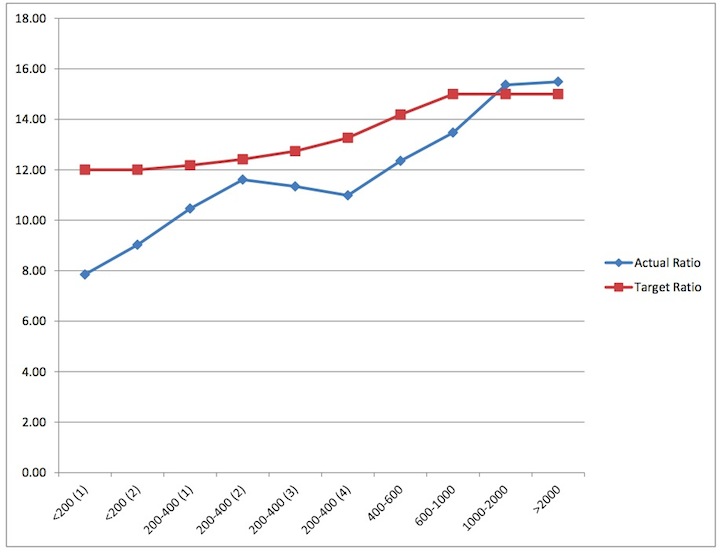An statistically inclined reader analyzes the state’s numbers on the new K-12 funding package and produces this table and chart showing how the new target student-teacher ratios on which the new school funding formula is based relate to actual staffing ratios in our 150 school districts.


The blue curve is where we are; the red curve is where the new funding formula in Senate Bill 131 says we should be. Taken by group, most small and medium school districts need to shed some teachers (or take on a bunch more students!) to climb up to the prescribed red ratios.
My calculations, which have focused on individual schools rather than aggregates by enrollment or other factors, show 118 schools with staffing totals higher than what the new K-12 formula will fund. The 45 smallest schools all have lower student-teacher ratios (i.e., more teachers) than SB 131 says they should. The median enrollment of the 32 schools that have student-teacher ratios higher than the formula funds is 973; the average enrollment among those lucky schools (lucky because they will get funding for more teachers than they currently have) is 2,019.
The above table and chart subsume those specifics into group averages, but they support the same conclusion: our new K-12 funding formula says that about 80% of our school districts have too many teachers, and in general, only our largest school districts, mostly those with four-digit enrollment (15 out of 23 of them, by my count), are achieving the staff efficiency our Governor and Legislature expect.
Cutting jobs is not an valid response to the teacher shortage. Teachers are not interchangeable components and you can shuffle students from one district to another. Some cases schools may be able to consolidate for incremental improvements in student/teacher ratios but how far should a Kindergartener have to travel to attend school?
This would be a good time for all of us to heed one of the lessons from “Fahrenheit 911”:
https://www.youtube.com/watch?v=6wfaIUeDNMk
And I will say it again and again, where did our leaders find $ 46 million in the new budget to pay off some of the State’s obligations early so that the future savings in interest costs from those obligations could then be redirected to our counties? Especially, when we were told by legislators on both sides of the aisle that there was no extra money in the new budget and that we would have to raise the sales tax in order to raise teacher pay……I guess if they do not read the bills, then how can they be expected to read the budget as well?
The problem is not too many teachers in our small school. We have paired down to just the basics. We are losing kids in our district to the nearby NE school because of the amount of time spent on the buses if we had to consolidate with another school farther away. We are a highly impacted school with a reservation and Lake Francis Case that are not paying taxes. Relying on the government for our yearly impact aid is very hard as they don’t tell you HOW MUCH or WHEN you will be receiving the money. Try establishing a budget with those hurdles!The last I knew, the government was several years behind in payments. We had 3 primary grades for the last several years with only 2 teachers and a para. Because many young families have moved back, we are looking at bigger class sizes in the future. Senator Billie Sutton was able to negotiate from 12.5 student to teacher ratio down to 12 garnering an extra $30,000 for our school. We need to not force consolidation if the school is able to stay solvent with the communities help. The big thing is for smaller class sizes to improve learning for our kids, 20 students seems to be the magic number.